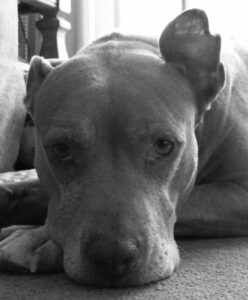Life With a Fearful Pittie

Our adventure began when my husband and I adopted our fearful American Staffordshire Terrier from a San Diego shelter. People sometimes call this breed of dog an Am Staff, or staffie, or pittie, or pibble. Even more people call it a pitbull, although I prefer the other nick-names.
We brought her home. We expected a different dog, once who was more attentive and calm. She did not stop moving for almost 3 days. She would not settle down and cried and vocalized whenever we left her alone. I was not a professional dog trainer at that time and I relied on the internet for information.
Although I was not a dog trainer, I had worked with zoo animals for 15 years and I knew that some of the information I was reading online was, at best, ineffective, and at worst, harmful and dangerous. How was I to know whom to trust? We researched further and finally found a trainer we felt would help us.
Understanding
As the weeks passed and we observed more of our pittie’s behaviors, we started to understand how fear was related to those behaviors. In fact, her lunging, barking, pulling, and elevated arousal all reflected her fear of her environment. We do not know her past. Many people assume she was abused, probably because she’s a pittie and probably because she’s afraid of dogs and some people. I don’t see any evidence of abuse, although I do see reactions that tell me her former owners punished her for some behaviors. More than likely, her former owners did not socialize her to various situations, environments, and people. It happens to many dogs, as there is a short window between about 8-12 weeks of age when proper socialization is significant to the development of a puppy. Socialization can take place for a few weeks afterward, but the earlier, the better.
Training
So, with the help of our trainer, we realized we had a fearful dog. We wanted to help our girl feel more comfortable. So, we started training consistently and taught her that she could make good things happen. We increased her confidence by working on puzzle-solving, fun tricks, and calming exercises. Gradually, she became more relaxed, and she rested more during the day. We could also leave the house for short periods without worry. She became more confident when people visited and she even was able to befriend the pest control man! She still gets excited when she sees him, wagging her tail and her body while making high-pitched calls.
Our little girl really has come a long way. She still does not like other dogs, but that’s ok because she doesn’t have to. Our pittie also prefers hanging out in the backyard versus going for a walk. And that’s ok, too. She makes us laugh, she’s playful, and at times, calm. We work on the fear whenever it appears, so that each instance is a learning experience. She will always have a fear of some things, but minimizing that fear is a priority for us and that comes through continuous training and patience. Having a fearful dog is not easy and can be quite stressful, but a good life with a fearful pittie is possible with training and understanding.
If you have a fearful pittie, there is help. Check out my website for more information about training and the ways I can assist both you and your dog. https://theproficientpup.com/private-training/
Lynn Webb, M.A., KPA CTP, CTMT


